Colloquium
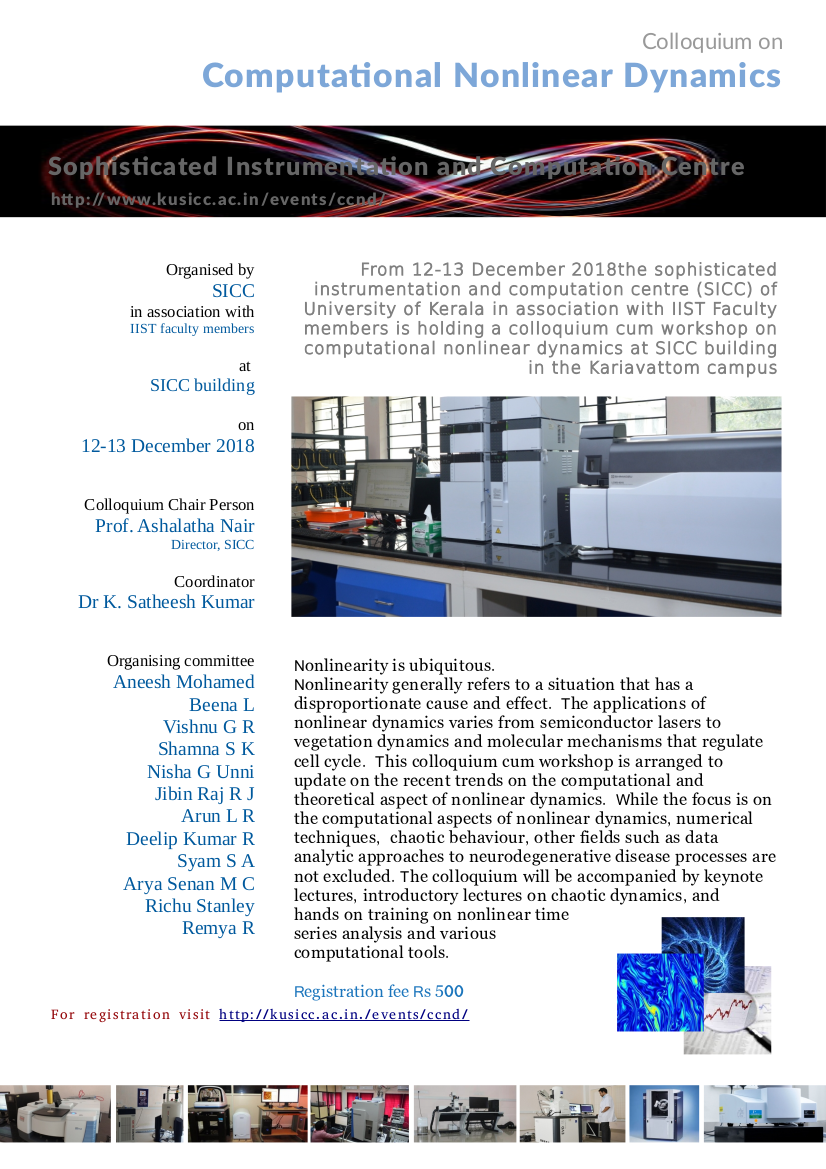
For more details contact:
Dr K. Satheesh Kumar, Ph: 919249438722 Email: ksktvm@gmail.com
Mr Deelip, Ph: 919847847165 Email: deelip.aa@gmail.com
Speakers
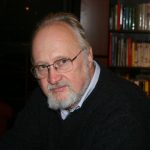 |
Prof.Dan Burghelea Dept of Mathematics OHIO STATE UNIVERSITY https://people.math.osu.edu/burghelea.1/ |
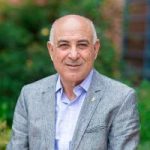 |
Prof. Saber N. Elaydi Dept of Mathematics TRINITY UNIVERSITY https://inside.trinity.edu/directory/selaydi |
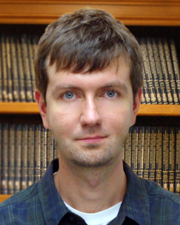 |
Dr Andrey S. Tsvetkov Department of Neurobiology & Anatomy UNIVERSITY OF TEXAS https://med.uth.edu/nba/faculty/andrey-s-tsvetkov/ |
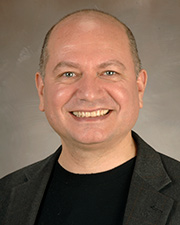 |
Dr Yuri A. Dabaghian Department of Neurology UNIVERSITY OF TEXAS https://med.uth.edu/neurology/faculty/yuri-a-dabaghian-phd/ |
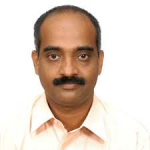 |
Prof. C. V. Anil Kumar Dept of Mathematics IIST, Trivandrum https://www.iist.ac.in/mathematics/anil |
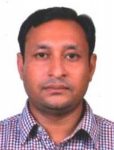 |
Dr Sarvesh Kumar Dept of Mathematics IIST, Trivandrum https://www.iist.ac.in/mathematics/sarvesh |
 |
Dr K. Satheesh Kumar Dept of Futures Studies University of Kerala https://keralauniversity.ac.in/dept/~kskumar |
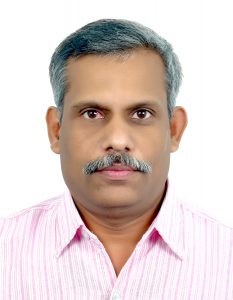 |
Dr Praveen Krishna Department of Aerospace Engineering IIST, Thiruvananthapuram |
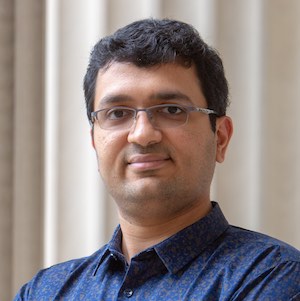 |
Dr. Deepak Subramani Dept. of Mechanical Engineering, Massachusetts Institute of Technology http://www.mit.edu/~deepakns |
 |
Dr Mamata Sahoo Department of Physics University of Kerala https://www.keralauniversity.ac.in/dept/biodata/6_1537349926.pdf |
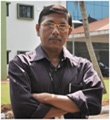 |
Dr Kaustabh Kumar Maiti CSIR-NIIST, Trivandrum http://www.niist.res.in/english/scientists/kaustabh- kumar-maiti/home.html |
Sessions
Session: Prof. Dan Burghelea. Dept of Mathematics, Ohio State University
Title: Dynamics and Morse-Novikov Theory
Abstract: Many of the dynamics of interest are mathematically modeled by smooth vector fields on smooth manifolds whose trajectories minimize an “action”, i.e. have a closed differential one form as Lyapunov. Morse-Novikov theory relates the elements of such dynamics (like rest points, instantons and closed trajectories) to the topology of the manifold. I will describe new computable invariants which make this relation more explicit and extends the class of dynamics the theory applies from vector fields on a manifold to flows on more general spaces (of interest outside mathematics).
Session: Prof. Saber N. Elaydi, Dept of Mathematics, Trinity University
Title: Recent advances in the study of global stability and global dynamics of monotone discrete dynamical systems
Abstract: We will survey the recent advances in the study of global stability and global dynamics of monotone discrete dynamical systems. Non-monotone amiable maps will be our next focus. Applications to population biology will be presented.
Session: Dr Andrey S. Tsvetkov, Department of Neurobiology & Anatomy, University of Texas
Title: High-throughput longitudinal single neuron imaging and analysis: performing clinical trials in a culture dish
Abstract: Toxic proteins have been implicated in most of the major neurodegenerative diseases, and identifying drugs that protect neurons from the toxicity of these proteins is of paramount importance. We use an automated imaging platform and longitudinal analysis, which are well suited to study neurodegeneration. These techniques enable the monitoring of large cohorts of individual neurons over their lifetimes as they undergo neurodegeneration in a culture dish. Multiple endpoints in neurons can be measured, including survival. Statistical approaches, typically reserved for clinical medicine, can be applied to these data to discover whether factors contribute positively, negatively or even neutrally to neuronal fate and to quantify the importance of their contribution. Therefore, the data generated with these methods can provide a systems-level understanding of the neurodegenerative disease processes and guide the rationale for the development of therapies.
Session: Dr Yuri A. Dabaghian, Department of Neurology, University of Texas
Title: Topological insights into the mechanisms of spatial cognition
Abstract: Spatial cognition in humans and mammals relies on the ability to form internal mental representations—cognitive maps—of their environments. Many parts of the brain contribute to producing these maps, and one of the central roles is played by the hippocampus—a brain area populated by location-mapping neurons—place cells. However, it remains unclear how exactly spatial information is being encoded and decoded in the brain, what is the nature of information encoded by each particular brain part. For example, it has been assumed that hippocampal place cells encode geometric information (specific locations, distances, angles). We argue that the temporal pattern of place cell activity conveys primarily qualitative relationships, such as overlap, containment, adjacency, etc., and hence that the map encoded by the hippocampus is primarily topological, i.e., more akin to a subway map than to a topographical street map. Using algebraic topology techniques (Persistent Homology theory), we demonstrate that the patterns of neuronal co-firing can, in fact, convey topological information about the environment in a biologically realistic length of time. Our simulations highlight the interplay between physiological parameters of the place cell activity and the topological dynamics of the map that they encode, e.g., they shed light on the conditions that impair spatial learning by altering place cells’ firing rates or spatial specificity. We propose that our model provides a coherent theoretical lens through which to understand basic principles of spatial cognition and the properties of the cognitive maps.
Session: Dr Praveen Krishna, Department of Aerospace Engineering, IIST, Thiruvananthapuram
Title: A multi-harmonic generalized energy balance method for studying autonomous oscillations of nonlinear conservative systems
Abstract: The Harmonic Balance Method (HBM) is a frequency-domain based approximation approach used for obtaining the steady state periodic behavior of forced dynamical systems. Intrinsically these systems are non-autonomous and the method offers many computational advantages over time-domain methods when the fundamental period of oscillation is known (generally fixed as the forcing period itself or a corresponding sub-harmonic if such behavior is expected). In the current study, a modified approach, based on He’s Energy Balance Method (EBM), is applied to obtain the periodic solutions of conservative systems. It is shown that by this approach, periodic solutions of conservative systems on iso-energy manifolds in the phase space can be obtained very efficiently. The energy level provides the additional constraint on the HBM formulation, which enables the determination of the period of the solutions.
Session: Dr Sarvesh Kumar, Department of Mathematics, IIST, Thiruvananthapuram
Title: On the numerical approximation of differential equations
Abstract: Differential equations help in describing many physical phenomena occurring in science and engineering; however, finding closed form analytical solution of differential equations would be a very difficult task and therefore, one has to look for suitable numerical techniques for obtaining numerical solution of differential equations. In this talk we discuss numerical approximation of nonlinear initial and boundary value problems with emphasis on both theoretical and computational aspects. In particular, we focus on finite difference methods and multistep methods for the approximation of nonlinear boundary and initial value problems, respectively. We also provide a brief overview on solution of nonlinear system of algebraic equations, which comes naturally after employing the discretization.
Session: Dr. Deepak Subramani, Dept. of Mechanical Engineering, Massachusetts Institute of Technology
Title: Uncertainty Quantification in Stochastic Nonlinear Dynamical Systems
Abstract: This talk focuses on the computational treatment of uncertainty in natural and engineering systems modeled as nonlinear dynamical systems governed by stochastic partial differential equations. Novel nonlinear and non-Gaussian data assimilation schemes will also be introduced. Applications from stochastic regional ocean predictions and path planning of autonomous underwater robots will be showcased.
Session: Dr Mamata Sahoo, Department of Physics, University of Kerala
Title: Stochastic Resonance and Role of Fluctuations
Abstract: Stochastic Resonance is a non-linear phenomenon where a weak input information can be enhanced/maximised by the assistance of noise. In this talk I will discuss about the Stochastic Resonance in a periodically driven (symmetric as well as asymmetric) double well potential system in the physics point of view. I will analyse the dynamics using both mathematical tools and computational methods. The main focus is on two questions (i) what are the new quantifiers of stochastic resonance and (ii) what happens to the fluctuations in different thermodynamic quantities, e.g., thermodynamic work and dissipated heat across the phenomenon stochastic resonance.
Session: Dr Kaustabh Kumar Maiti, NIIST, Trivandrum
Title: Recent Development on Surface Enhanced Raman Spectroscopy (SERS)-Based Chemometric Prediction of Human Cancer Proliferation

